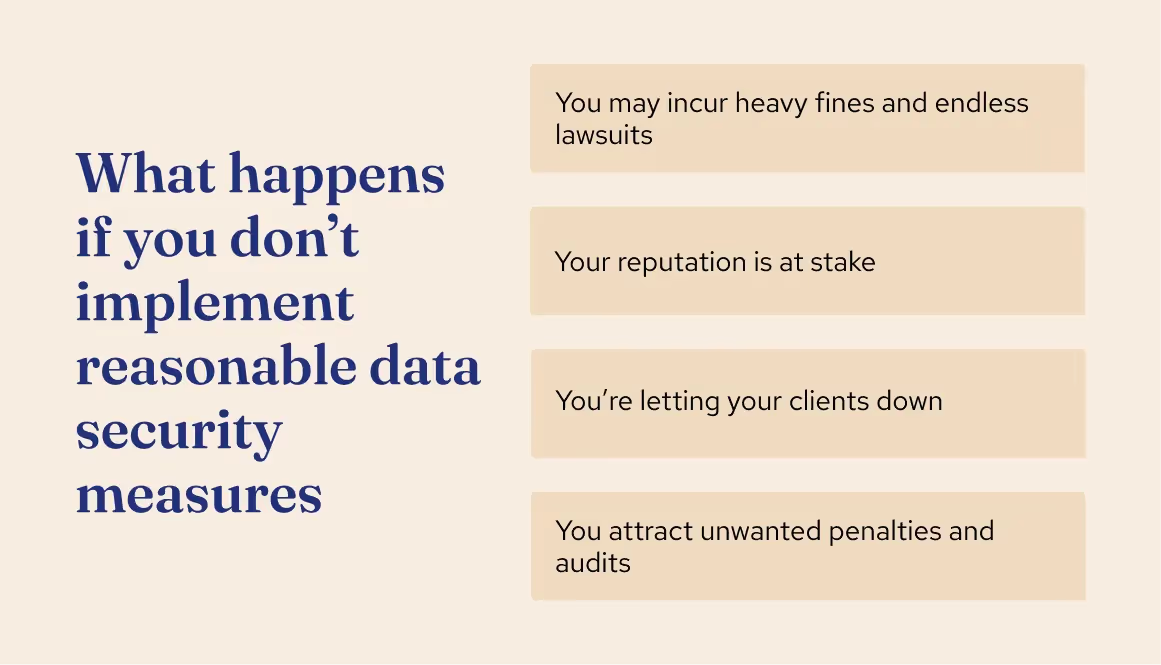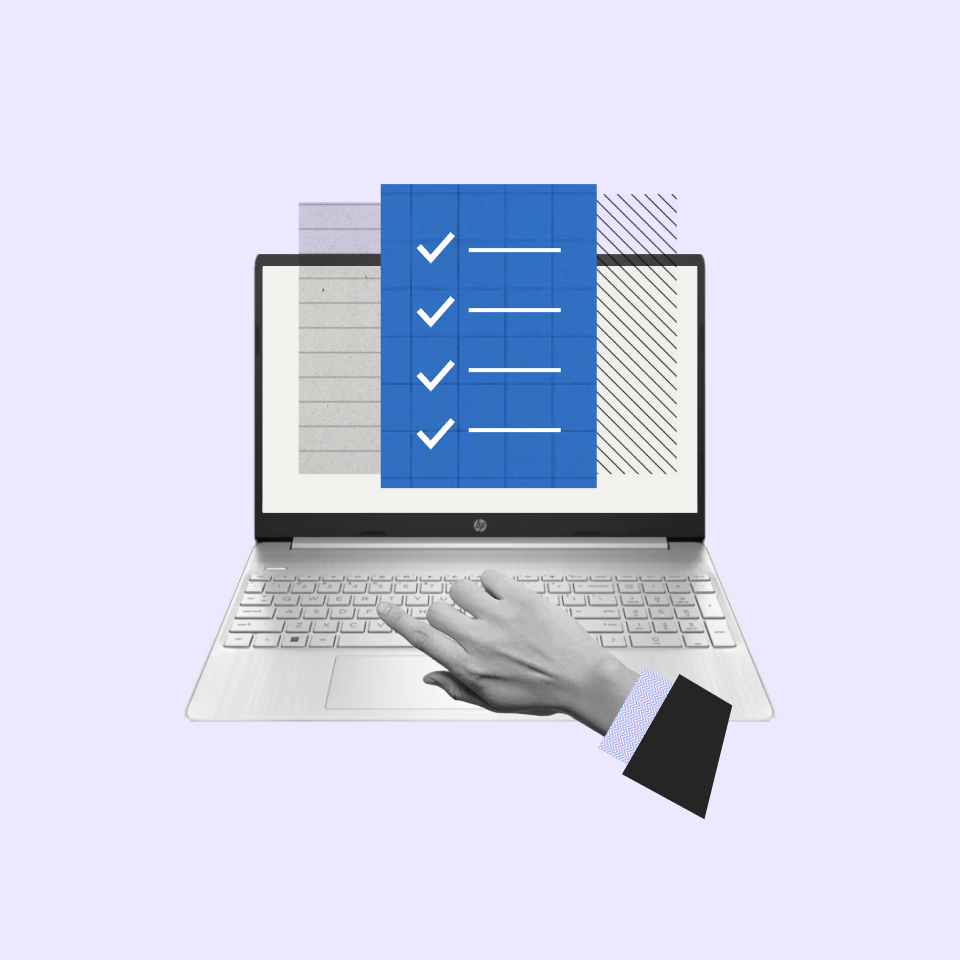You're sifting through your morning emails when a notification pops up, only this one isn't from a colleague or a client. It's from law enforcement informing you that your company's confidential files are circulating on a notorious hacker forum.
In recent years, the chances of a breach have surged, and implementing a data security framework for your in-house legal team is more important now than ever.
As your company's in-house legal expert, your involvement in these critical aspects is not just advised – it's paramount. Let’s see how you can help your company safeguard critical data.
What are reasonable data security measures?
Reasonable data security measures for legal teams entail a strategic approach to safeguarding sensitive data, ensuring client confidentiality, and maintaining the integrity of legal proceedings.
When it comes to data security, legal folks have a strategic role to play. You’re not just safeguarding data; you’re protecting the trust your clients and colleagues place in you.
Think about it: you handle sensitive data day in and day out. It's not just about locking things up; it's about making sure client info stays confidential and your legal proceedings are rock solid.
“One thing I have learned is that data privacy is actually pretty straightforward, common sense stuff: Tell people what you are doing with their personal data, and then do only what you told them you would do. If you and your company do this, you will likely solve 90% of any serious data privacy issues.”
~ Sterling Miller, CEO of Hilgers Graben PLLC
Ten Things: Data Privacy – The Essentials
Various industry standards and regulations guide how your data should be protected. Aligning data security practices with these standards, such as the General Data Protection Regulation (GDPR) and the Health Insurance Portability and Accountability Act (HIPAA), will showcase your commitment to compliance and due diligence.
What happens if you don’t implement reasonable data security measures

You might think, “It’s been years; we haven’t had a security incident. Why would it happen now?” or
“We’re a small company! Data security isn’t our top priority.”
But this is a recipe for disaster. Let’s find out why.
#1 You may incur heavy fines and endless lawsuits
First off, legal actions might come knocking. Lawsuits and fines can hit hard when client data gets leaked or mishandled.
Regulatory bodies are tightening their grip on data protection, and they're not lenient when it comes to violations. Financial penalties for data breaches can be hefty, and these financial hits can put a significant dent in your resources, affecting the bottom line of your legal operations.
#2 Your reputation is at stake
It's not just about the wallet – your reputation takes a nosedive. The legal world operates on trust and credibility. In-house legal teams are relied upon not only for their legal prowess but also for their discretion. Mishandling client data sends shockwaves through your reputation.
The legal community is closely interconnected, and news of security breaches travels quickly. The result? A tarnished reputation that's hard to recover from.
#3 You’re letting your clients down
Clients put their faith in in-house legal to keep their info safe. Breach that trust, and you might be waving goodbye to those long-standing partnerships. It's not just business; it's about respect and reliability.
#4 You attract unwanted penalties and audits
Remember those industry standards we talked about? Ignoring them can raise eyebrows – from regulators, no less. Failing to follow GDPR, HIPAA, or other regulations can bring down a hailstorm of penalties and audits.
Audits demand your time, resources, and attention, diverting your focus from the core legal work you're passionate about. These distractions can disrupt your workflow and hinder your ability to serve your company effectively.
Best practices to design and implement data security measures

To help you navigate the complex landscape of data protection, here are some practical best practices to design and implement top-notch data security measures:
#1 Develop a comprehensive data governance framework
Think of data governance as your playbook. Establish clear guidelines, responsibilities, and procedures for managing data across its lifecycle. A solid governance framework ensures everyone is on the same page and minimizes the risk of data mishandling.
- Assign clear responsibilities for different aspects of data management. Who's in charge of data access? Who handles data retention?
- Categorize and prioritize your data based on its sensitivity and importance
- Document step-by-step procedures for data handling, from collection to disposal. This leaves no room for confusion and ensures consistency in how data is managed
Also read: How to Establish a Successful Contract Governance Framework
#2 Risk assessment is your North Star
Regularly assess potential risks and vulnerabilities within your data infrastructure. This proactive approach helps you stay one step ahead of potential threats and allows you to shore up defenses where needed.
“One of the ways I build trust is by demonstrating to stakeholders that we evaluate risk thoughtfully and intelligently. We understand we are not, for example, a closely-regulated Fortune 50 pharmaceutical company. So we have a bit more freedom, but we exercise it responsibly.”
~ Jonathan Franz, Head of Legal at Crunchbase
Navigating Economic Turbulence and Thriving in Chaos
- Pinpoint the most critical data assets in your arsenal. These could be confidential client information, sensitive legal documents, or proprietary research
- Visualize how data moves within your systems. Identify entry and exit points, storage locations, and any potential bottlenecks
- Invest in automated tools that scan your systems for vulnerabilities. Regular scans help you uncover weak points before malicious actors do, giving you the upper hand in fortifying defenses
- Keep a finger on the pulse of emerging trends and new tactics used by cybercriminals. This proactive approach helps you anticipate and prepare for potential attacks
Finally, your risk assessment isn't a solo act. Engage stakeholders from different departments. They might offer unique insights into data flows and vulnerabilities you hadn't considered.
Also, if you're collaborating with external partners, assess their data security practices too. Weak links in your chain can compromise your overall data security.
Also read: Effective Contract Risk Management: Top Tips & Strategies
#3 Access control is key
Control who gets a backstage pass to your data. Role-based access ensures that only authorized personnel can view and handle sensitive information.
- Follow the principle of least privilege. Give users the minimum access necessary to perform their tasks. Less access means less room for error or misuse
- You could also add an extra layer of security with 2FA. Even if someone manages to get a password, they'll need an additional authentication step to gain access
- Set up automatic access expiry. When an employee leaves or changes roles, their access should be adjusted accordingly. This eliminates the risk of lingering permissions
- Keep a watchful eye on who's accessing what. Regularly review access logs and audit trails. Any unusual activity can be spotted early and dealt with
#4 Keep encryption in mind
Encryption isn't just a fancy term – it's your data's bodyguard. Encrypt data both at rest and in transit to make sure even if someone does manage to sneak a peek, all they'll see is gibberish.
- Choose strong encryption algorithms like AES (Advanced Encryption Standard) that are widely recognized for their security
- When data is chilling on servers or storage devices, encrypt it. Even if someone gains unauthorized access, they won't be able to make sense of the encrypted gibberish
- When data is on the move, use encryption to protect it during its journey. This is crucial when exchanging sensitive information over the internet
- Encryption relies on keys and passwords. Keep these secure
- If you're dealing with sensitive communications, use end-to-end encryption. This ensures that only the sender and recipient can decode the messages, keeping prying eyes at bay
- Use full-disk encryption to make sure that even if a device is lost or stolen, the data on it remains locked
- If you're using cloud services, look for options that provide encryption. Cloud encryption ensures that your data remains confidential, even when stored remotely
#5 Educate and train your team
Data security isn't a one-person show; it's a team effort. Regularly educate and train your team about security protocols, phishing prevention, and how to spot suspicious activities. After all, your team's only as strong as its weakest link.
“The most inexpensive way to help prevent a data breach is by properly training your workforce. This includes training on creating proper passwords (along with having technology that requires those passwords to meet certain criteria and be changed frequently); how to spot social engineering attempts (e.g., “Phishing”); what to do with suspicious emails (i.e., don’t click on the links and report it to IT office immediately); and how to be alert for industrial espionage (unauthorized visitors, picking up strange USB flash drives and plugging them into your computer to see what’s on them, etc.).”
~ Sterling Miller, CEO of Hilgers Graben PLLC
Ten Things: Things In-House Counsel Should Be Doing Before a Data Breach Occurs
- Schedule regular workshops that cover the latest security protocols, best practices, and emerging threats
- Conduct simulated phishing attacks to help team members recognize phishing attempts and avoid falling for them
- Customize training based on roles. What a lawyer needs to know might differ from what an administrative assistant needs
- Conduct quizzes or assessments after training sessions. This reinforces learning and helps identify areas that might need more attention
#6 Establish clear data retention and disposal policies
Data clutter is as bad as a messy desk. Set up policies that define how long data should be retained and when it should be securely disposed of. This reduces the risk of holding onto unnecessary data that might become a liability.
- Start by identifying regulations that dictate how long certain types of data need to be retained. Different industries might have specific retention periods you need to adhere to
- Not all data has the same lifespan. Categorize your data into different types based on its purpose and sensitivity. This helps you tailor retention policies accordingly
- Set clear timelines for how long each category of data should be retained. Balance business needs with regulatory requirements to find the right retention periods
- Implement automated systems that track data retention periods and trigger disposal processes when data reaches the end of its lifecycle
- Archived data might need to be retained for compliance but not accessed regularly. Store archived data in a secure location, ensuring it's protected while taking up minimal space
- Define clear procedures for data disposal. How should data be securely deleted or destroyed? Having documented procedures ensures consistency
- In some cases, data retention might be paused due to legal holds in the event of litigation or investigations. Ensure your policies account for these scenarios
Tip: Leverage the best practices given in National Institute of Standards and Technology (NIST) Cybersecurity Framework to develop policies.
#7 Monitor and enforce compliance
Regulations aren't just guidelines; they're rules you need to follow. Continuously monitor your data security practices to ensure they're compliant with industry standards and regulations like GDPR and HIPAA.
- Schedule regular audits to assess your data security practices. This proactive approach helps identify gaps and deviations from compliance standards
- Set measurable KPIs related to compliance. These could include the frequency of audits, incident response times, or successful policy implementations
- Clearly define consequences for non-compliance with data security policies. This underscores the seriousness of adhering to regulations
- Consider engaging external auditors to assess your compliance practices. Their independent evaluation provides an unbiased perspective
- Communicate your compliance efforts to stakeholders, demonstrating your commitment to maintaining the highest standards
Also read: Tracking Contract Compliance: Best Practices + Tools
#8 Partner with IT
You're legal experts, but you're not alone in this battle. Collaborate closely with your IT department to align data security measures with technical infrastructure and practices.
“For those organizations that are ingesting new tooling, you need to figure out where you are on the risk meter from the data use perspective.”
~ Ken Priore, ex-Director of Privacy, Atlassian
Mastering the Intersection of Law, Technology, and Privacy
- Establish open channels of communication with your IT counterparts. Regular updates and meetings keep both sides informed and aligned
- Collaborate on developing a comprehensive data security strategy. Leverage legal insights and IT technical expertise to create a robust plan
- When IT considers new technologies, provide legal input. Ensure that solutions comply with regulations and industry standards
- Work together to conduct PIAs for new projects or systems. Assess potential privacy risks and devise mitigation strategies
- IT holds the technical map of your data landscape. Collaborate to accurately map data flows, storage locations, and access points
- Develop incident response plans together. Determine legal steps and technical actions required in the event of a data breach
- Organize cross-training sessions. Legal gets insights into technical aspects, and IT gains awareness of legal requirements
- Review data use policies and ensure they align with legal standards. Clarify how data can be used while staying compliant
Also read: Legal Risk Management: From the Playbook of 11 GCs and Leaders
Start building a robust data security posture
Data security is a journey, not a destination. Regularly review and update your security measures to stay ahead of evolving threats and ensure you're always compliant with the latest regulations.
Remember, data security isn't just about protecting information; it's about safeguarding the trust and integrity that your clients and colleagues place in you. By following the best practices in this post, you're not just building a defense against potential threats – you're showcasing your commitment to excellence in the world of data protection.
Stay tuned for more!


.png)







